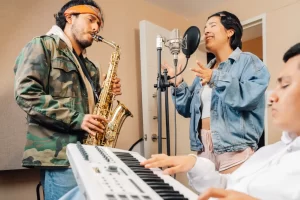Music education, a fundamental pillar in nurturing creativity and cultural appreciation, has historically thrived in classrooms and private lessons. These traditional settings have provided a rich, interactive environment for learning instruments, theory, and performance. However, the advent of digital technology has ushered in a transformative era for this revered discipline. The integration of online learning and educational apps into music teaching and learning is not just a trend but a significant shift in pedagogical approach. This digital transformation, accelerated by the global pandemic, has redefined accessibility, learning methods, and the overall experience of music education.
This blog post aims to explore the multifaceted impact of this digital revolution in music education. We will delve into how online platforms and apps have reshaped learning experiences, offering unprecedented access and personalized learning opportunities. Additionally, we will discuss the challenges and potential of these digital tools, providing insights for educators, students, and enthusiasts. Our journey through the evolving landscape of music education will highlight not only the technological advancements but also the enduring importance of music as a universal language of expression and connection.
The Shift to Online Music Education
The landscape of music education has undergone a significant transformation, pivoting from traditional classroom and studio settings to an increasingly digital domain. This shift, while gradual, has been propelled rapidly forward by global events such as the COVID-19 pandemic, which necessitated a swift move to online platforms for continuity in education.
Historical Perspective: Traditional vs. Digital Music Education
Traditionally, music education has been deeply rooted in physical interactions – one-on-one lessons, group rehearsals, and live performances. The tactile experience of learning an instrument, the dynamic of a conductor leading an orchestra, and the immediate feedback loop between teachers and students formed the core of this learning process. However, digital music education has started to replicate these experiences through technology, offering new dimensions of interaction and learning.
Impact of the Pandemic on Music Education
The pandemic served as a catalyst for a widespread transition to online music education. Schools and private instructors, initially out of necessity, adopted digital tools and platforms to continue teaching. This shift was not without challenges, such as adapting teaching methods to a virtual format and ensuring students had access to necessary technology and instruments at home.
Benefits of Online Learning in Music
- Accessibility and Flexibility: Online music education breaks geographical barriers, allowing students to access high-quality resources and instruction from anywhere in the world. This flexibility also extends to scheduling, making it easier to fit music education into diverse and busy lifestyles.
- Diverse Learning Resources: Digital platforms offer a wealth of resources, including video tutorials, interactive theory lessons, and digital sheet music, catering to different learning styles and levels.
- Individualized Learning Paths: Online learning often allows for more personalized education. Students can progress at their own pace, revisit lessons as needed, and choose content that aligns with their individual interests and goals.
The transition to online music education is not merely a temporary solution but a glimpse into the future of how music can be taught and learned. As technology continues to evolve, so too will the methods and effectiveness of digital music education, potentially leading to a more inclusive, flexible, and personalized learning experience.
Overview of Popular Music Education Apps
In the realm of music education, the emergence of a plethora of apps has revolutionized how students and educators approach learning. These apps cover a broad spectrum, from those focusing on individual tutoring and music theory to specialized apps for learning specific instruments. They’ve become indispensable tools, offering new, engaging ways to interact with the fundamentals and intricacies of music.
Tutoring apps in the market are redefining traditional learning models, providing virtual lessons complete with interactive features that allow for real-time feedback and tracking of progress. Complementing these are theory apps, which delve into the foundational elements of music education such as music theory, ear training, and reading music. These are pivotal for building a solid base in any musical education journey. For those focusing on mastering a particular instrument, there are dedicated apps that provide structured lessons, exercises, and in some cases, use augmented reality for a more immersive experience.
The effectiveness of these music education apps lies in several key attributes. Firstly, they typically feature a user-friendly interface, making them accessible to a wide range of users, irrespective of age or tech-savviness. Another critical feature is the ability to offer customizable learning paths. This personalization allows users to engage with content that aligns with their individual skill level and learning goals. Adding to the interactive nature of these apps are various engaging elements such as games and quizzes, which not only make learning fun but also reinforce knowledge. Perhaps one of the most significant features is the provision of real-time feedback. This instant evaluation helps students to identify and correct mistakes promptly, facilitating a quicker and more efficient learning process.
From apps designed for beginners, which focus on basic skills and concepts with engaging, game-like interfaces, to those aimed at intermediate and advanced learners, offering more complex lessons and in-depth analysis, the range is extensive. For advanced musicians, certain apps provide opportunities not just for learning but also for composing and improvisation, pushing the boundaries of traditional music education.
The current landscape of music education apps is a testament to how technology can enhance and expand the ways in which we engage with and understand music. As these apps continue to evolve, they not only serve as a complement to traditional methods but also open new doors for creativity, exploration, and personalization in the journey of musical learning. In this new era, technology and art converge, offering learners novel and exciting ways to explore the vast world of music.
Integrating Apps into Traditional Music Education
Integrating apps into traditional music education presents a unique blend of old and new learning methodologies, creating a hybrid or blended learning environment. This integration is not about replacing the traditional methods but enhancing them with the benefits of digital technology. The challenge for educators is to find the right balance, utilizing apps as a supplement to deepen understanding and engagement with music.
The key to successful integration lies in a strategic approach. Educators can use apps to provide students with additional resources that complement classroom teaching. For instance, theory apps can be used to reinforce topics covered in class, while instrument learning apps offer students the opportunity to practice skills outside of the classroom at their own pace. This approach not only diversifies the learning experience but also caters to different learning styles and speeds.
Moreover, apps can be instrumental in keeping students engaged and motivated. The interactive and often game-like nature of many music education apps makes learning fun and appealing, especially for younger students. They provide a sense of immediacy and feedback that is sometimes hard to achieve in a traditional classroom setting. This instant feedback loop can be particularly beneficial for skill acquisition and retention.
However, this digital integration also comes with its set of challenges. It’s crucial for educators to ensure that the use of apps does not diminish the importance of human interaction and the invaluable experience of live, collaborative learning. The goal should be to use technology as a tool to enhance these experiences, not replace them.
The integration of apps into traditional music education offers a promising avenue for enhancing learning experiences. By strategically incorporating these digital tools, educators can provide a more engaging, flexible, and personalized learning environment. However, the balance between technology and traditional teaching methods must be carefully managed to ensure that the essence of music education – human connection, expression, and collaboration – remains at the heart of the learning experience.
Challenges and Considerations
As the digital transformation of music education progresses, it is crucial to address the challenges and considerations that come with this shift. One of the primary concerns is maintaining the quality and rigor of musical education through online platforms. While digital tools offer unparalleled accessibility and convenience, ensuring that these platforms provide a comprehensive and robust learning experience is essential. Educators and developers must collaborate to create content that not only engages students but also adheres to high educational standards.
Another significant challenge is the digital divide. Access to technology is not uniform across different socio-economic backgrounds, and this disparity can create gaps in learning opportunities. Schools and educational institutions must seek ways to make digital resources more accessible to all students, ensuring that the move towards online learning does not exclude or disadvantage any group. This might involve providing devices or internet access to those in need or finding hybrid solutions that combine digital and traditional resources.
Balancing technology with human interaction is also a key consideration. Music, inherently a social and collaborative art form, thrives on human connection, whether it’s between teacher and student or among peers. While apps and online platforms offer new ways to learn and practice, they cannot fully replicate the nuances of in-person interactions and live performances. It’s vital for educators to strike a balance, using digital tools to enhance learning while preserving the irreplaceable elements of face-to-face teaching and live musical experiences.
In addressing these challenges, the goal should be to harness the potential of digital tools to democratize and enrich music education, while being mindful of maintaining quality, inclusivity, and the essential human elements that lie at the heart of music. This balanced approach will be crucial in shaping a future where technology supports and enhances the timeless art of music education.
The Future of Music Education
The future of music education appears to be an exciting amalgamation of tradition and technology, heralding new possibilities and challenges. As we move forward, emerging trends and technologies are poised to further transform how music is taught, learned, and experienced.
One of the most significant trends is the increasing use of Artificial Intelligence (AI) and Virtual Reality (VR) in music education. AI has the potential to revolutionize personalized learning, offering customized lessons and feedback that adapt to the individual learner’s pace and style. Imagine an AI-driven app that can listen to a student play, provide instant feedback, suggest improvements, and even predict areas of difficulty before they become problematic. Similarly, VR can create immersive learning environments, simulating everything from a private lesson to a full orchestra experience, providing learners with experiences that were once logistically impossible or financially prohibitive.
Another future aspect is the growing emphasis on collaboration and connectivity. With the rise of online platforms, students from different parts of the world can collaborate, share ideas, and learn from each other. This global networking not only enriches the learning experience but also fosters a sense of a global music community.
The integration of music education with other academic disciplines, known as STEAM (Science, Technology, Engineering, Arts, and Mathematics), is also gaining traction. This interdisciplinary approach can make music education more holistic, showing students the connections between music and other fields, thereby enhancing their overall educational experience.
Despite these technological advancements, the core essence of music education – fostering creativity, expression, and human connection – will remain central. Technology will serve as a tool to enhance these elements, not replace them. The future of music education will likely be one where traditional methods are supported and amplified by the advancements in technology, making music education more accessible, engaging, and comprehensive than ever before.
To Sum It Up
In conclusion, the digital transformation of music education is a journey that intertwines the rich heritage of traditional teaching with the innovative possibilities of modern technology. This evolution, marked by the integration of online learning and a plethora of educational apps, is reshaping the landscape of music education, making it more accessible, customizable, and interactive than ever before. The shift to digital platforms, while presenting challenges such as maintaining educational quality and addressing the digital divide, also offers a wealth of opportunities to enhance and enrich the learning experience.
As we look to the future, the potential of technologies like Artificial Intelligence and Virtual Reality in music education is vast, promising even more personalized and immersive learning experiences. However, the heart of music education—fostering creativity, expression, and connection—remains unchanged. Technology, in its many forms, is a tool to augment this core, not to overshadow it.
Embracing this digital transformation in music education is not just about keeping pace with technological advancements but about opening new doors for learners and educators alike. It is an invitation to explore, innovate, and connect in ways previously unimagined, while holding steadfast to the timeless value that music brings to our lives and societies.




